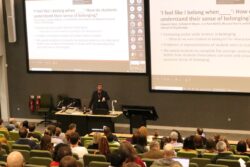Hybrid at Scale: Leeds Student Education Conference 2023
In the first week of January, the LITE Team hosted the Leeds Student Education Conference 2023- an event for over 450 people where we held four plenary sessions and two sets of parallel sessions, each with five concurrent panels. Delegates and presenters were able to choose whether they would like to attend the sessions in person at locations on campus, or online via Teams.
What did you do and why did you do it?
As a team we wanted to produce the most user-friendly, equitable experience that we could for our delegates. This process began at the sign-up phase where LITE Institute Manager, Ben Witz, implemented a Power Automate Flow, which automatically sent Teams/Outlook calendar invitations out to delegates once they had filled out a Microsoft Form. This enabled delegates to have information on the physical location of the room and the link to the Teams meeting. Having this option meant that delegates could choose their method of participation (and alter at short notice, if necessary) throughout the two days.
To ensure that the online experience was as equitable as it could possibly be, there were three strategic steps that we needed to take:
- We experimented with delivering hybrid events, on a smaller scale. In the months preceding the conference we tried out different rooms and different in-room equipment on a trial-and-error basis to build our knowledge and confidence in what worked best.
- We made sure that we had the support of the Central Teaching Spaces Team. They were excellent in helping us to set up the rooms for hybrid delivery via Teams and were crucial to sorting out the few hiccups that we had during the two days.
- We ensured that we made chairing, presenting and attending the conference as easy as possible. To do this we communicated effectively with all presenters, chairs, and the SES project team, who were on hand to provide support. We set up Teams chat threads which included clear instructions for chairs, presenters, and delegates. These provided the opportunity to ask questions and chairs were invited to an orientation event (details are in the information for chairs) in the specific rooms that they would be responsible for. We also put a crib sheet in each room as a reminder on the day and made sure that presenters had entered their slides into a shared deck that the chair and presenters could easily access and share.

Ed Venn delivers a plenary snap session
What was the impact of your practice and how have you evaluated it?
Our LITE colleague, Ki Woong Nam, has produced an analysis of the evaluation form that we sent out to delegates immediately after the final plenary of the conference. Comments regarding the hybrid element of the conference were overwhelmingly positive. The feedback demonstrated that going hybrid not only allowed delegates to attend the conference when previously it hasn’t been possible, but also allowed them to attend more sessions as they were able to switch hassle-free between attending in-person and online.
The feedback also demonstrated that the conference went as far as changing the opinions of those that would have previously considered themselves sceptical of a hybrid delivery model.
The event wasn’t without its hiccups; in the first plenary session our Vice Chancellor was muted for the audience at home for a small amount of time; on day one, presenters at home could not hear questions that were asked in the room; and on day two, one presenter’s slides had not been entered properly into the deck for one of the plenary snap sessions. We were able to overcome these issues relatively quickly due to having the Central Teaching Space Team on hand and having built up our own experience over the past year. There’s no such thing as a perfect conference- all you can do is try to mitigate against problems and be confident in your ability to overcome them.
Since the conference, I’ve been in touch with eleven different conference or event organising committees that have been seeking advice on how to deliver a hybrid event- people have seen that hybrid is possible and that a more equitable and accessible event experience is possible. The success of the SEC also influenced and built confidence for the decision to deliver the upcoming RAISE Conference, to held at Leeds in September, in a hybrid format.
How could others benefit from this example?
All of the tech and software that we used for the conference is already licensed and installed throughout the University- this includes Power Automate, which is part of the Office 365 package. An event on the scale of the Student Education Conference requires a lot of forethought and planning, but at its basic level you can make an event hybrid as long as there is a ceiling-mounted camera and a microphone in the room.
Author
Dave Riley, D.D.Riley@Leeds.ac.uk, LITE
With thanks also to: Ben Witz, Emma Peasland, Ki Wong Nam, Isobel Whitehouse, Rekha Parmar.
Do you have an example of your practice to share?
If you are interested in submitting an article to the TIPS Blog find out how to submit here, or contact the TIPS Editors at academicdev@leeds.ac.uk
